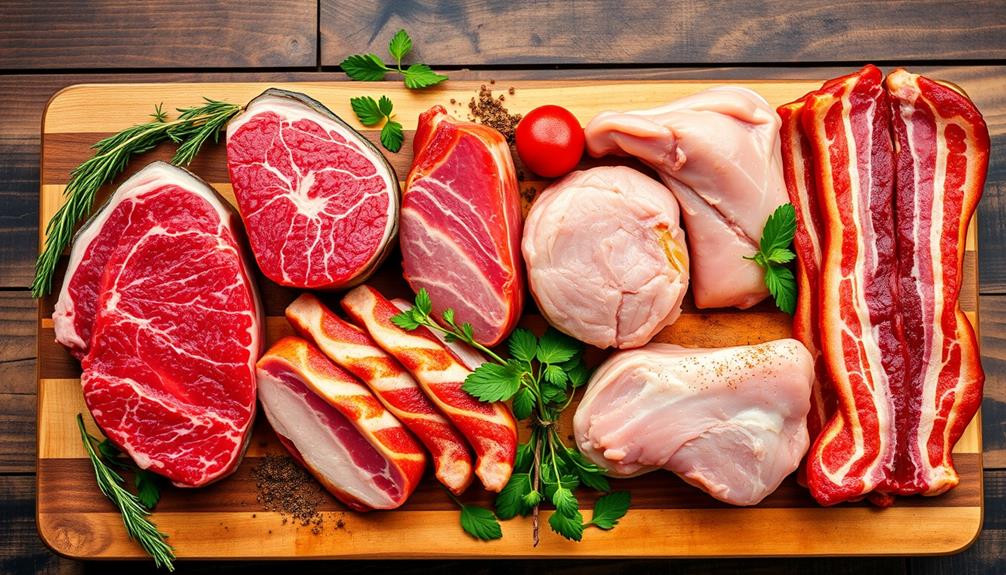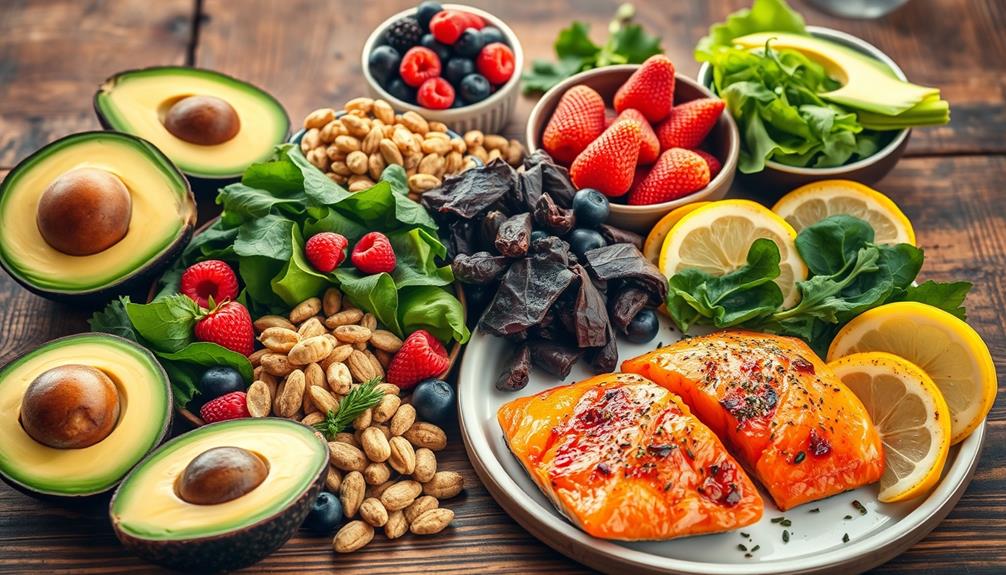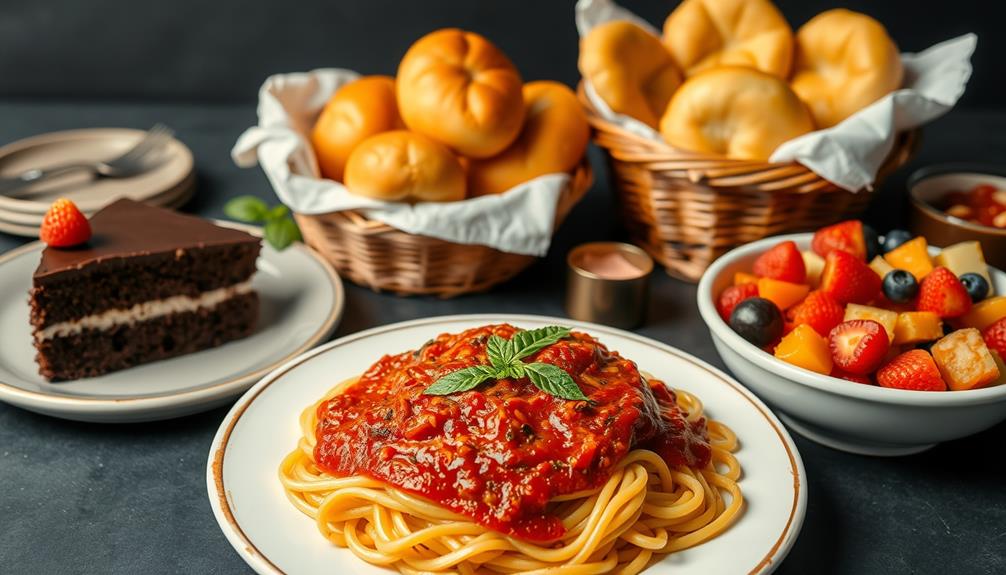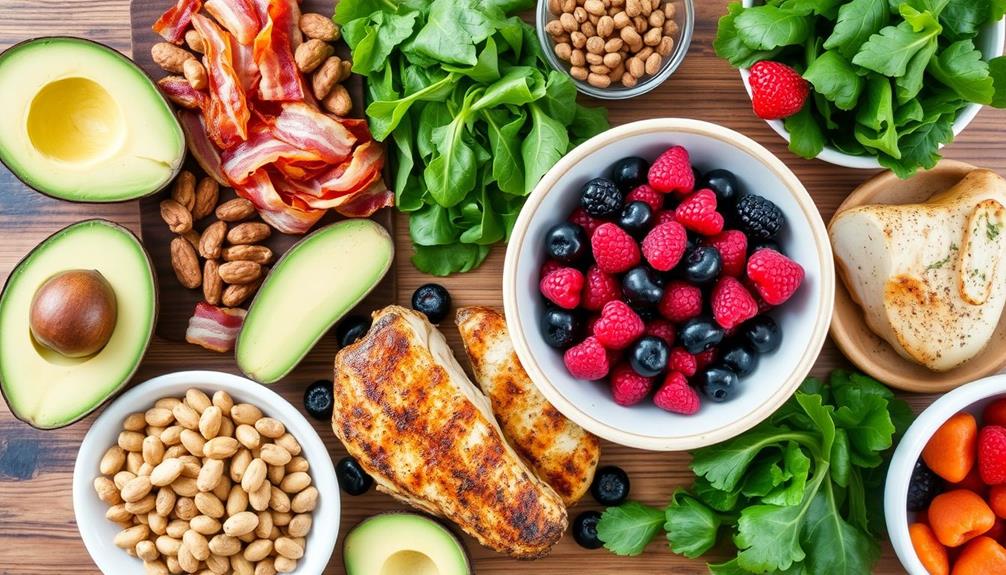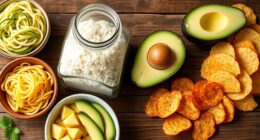The best meats for a keto diet focus on high-fat, low-carb options. You can't go wrong with grass-fed beef, which offers healthy fats and a solid protein punch. Pasture-raised pork also makes a flavorful choice, while chicken thighs provide higher fat content compared to breasts. Fatty fish like salmon and mackerel are rich in omega-3s and nearly carb-free. Just steer clear of processed meats and sweet marinades, as they can disrupt your carb intake. Keep exploring, and you'll uncover even more delicious options and tips to elevate your keto meals! And don’t forget about the best ketofriendly fish choices like sardines, trout, and tuna. These options are not only high in healthy fats and protein, but they are also low in carbs, making them perfect for a keto diet. Experimenting with different cuts of meat and types of fish can keep your meals exciting and satisfying while staying on track with your keto goals.
Key Takeaways
- Prioritize unprocessed meats like grass-fed beef, pasture-raised pork, and dark meat poultry for optimal keto nutrition.
- Choose fatty fish such as salmon and mackerel for high omega-3 content and minimal carbs.
- Avoid high-carb meats like battered options, processed deli meats, and those with sweet sauces or marinades.
- Select high-fat cuts like ribeye or pork belly to enhance satiety and support fat intake.
- Incorporate keto-friendly cooking methods and pair meats with low-carb vegetables for balanced meals.
Allowed Meats on Keto

When you're following a ketogenic diet, knowing which meats are allowed can make your meal planning easier. Focus on unprocessed meat options to stay aligned with keto principles. Grass-fed beef, pasture-raised pork, and chicken are excellent choices that provide high protein and low carbohydrates.
Additionally, incorporating meats that are rich in antioxidants can support overall health, similar to how cranberry juice consumption benefits the body.
Dark meat poultry, particularly chicken thighs, is your friend on this diet due to its higher fat content, which can enhance satiety. Switching to these cuts can help you feel fuller longer while keeping your carb intake low.
Seafood options, especially fatty fish like salmon and mackerel, are also highly recommended. These fish are rich in omega-3 fatty acids, essential for heart health, and they contain nearly zero carbohydrates—ideal for maintaining ketosis.
Meats to Avoid

When following a keto diet, it's vital to steer clear of high-carb meats that can sabotage your goals.
Certain zodiac signs may have a natural inclination towards healthy eating habits, making it interesting to explore how astrological compatibility can influence your dietary choices.
Processed meats often hide sugars and additives, making it essential to read labels closely.
High-Carb Meats
Steering through the keto diet requires careful attention to the types of meat you choose, especially if you're aiming to keep your carb intake low.
One major category of high-carb meats to avoid includes battered or breaded options, like chicken nuggets and fried fish. These coatings elevate their carb content considerably. Similarly, meats glazed or marinated with sweet sauces, such as barbecue or Hoisin, can lead to a carb overload, making them unsuitable for your low carb diet.
It's important to remember that credit score can impact your financial decisions, including those related to food purchases and meal planning.
You should also be cautious with processed meats. Pre-made meatballs and meatloaf often contain breadcrumbs or fillers that increase their carb levels, so it's best to limit these.
Breakfast meats, including certain sausages and deli meats, can hide added sugars and starches, so always read labels carefully to avoid unwanted carbs. Additionally, sauced or heavily seasoned meats may have added sugars that negate the benefits of a keto-friendly diet.
Stick to plain or minimally processed options to stay on track. By being mindful of these high-carb meats, you can maintain a successful keto journey.
Processed Meat Pitfalls
Choosing the right meats is essential for staying on track with your keto diet, especially when it comes to avoiding processed options. Processed meats can be deceptive, often packed with hidden sugars and additives that spike their carbohydrate content. To keep your keto goals intact, steer clear of the following processed pitfalls:
| Processed Meats to Avoid | Reason |
|---|---|
| Battered or Breaded Meats | High in carbs due to coatings |
| Sauced Meats | Sweet marinades add considerable carbs |
| Premade Options | Often contain breadcrumbs |
| Deli Meats | May include starches or fillers |
| Cured Meats | Can disrupt carbohydrate intake |
Instead, focus on whole cuts and unprocessed meats. These options are naturally low in carbs, making them perfect for a ketogenic diet. Choose fresh chicken, beef, pork, and fish to guarantee you're fueling your body with clean, nutritious options. By being mindful of processed meats, you'll better support your keto lifestyle and achieve your dietary goals.
Nutritional Benefits of Meats

Meat is a powerhouse of nutrition, especially for those following a keto diet. When you choose the best keto meats, you're fueling your body with high-quality protein and essential nutrients.
Grass-fed beef, for instance, offers about 20g of protein and 13g of fat per 100g serving, along with crucial nutrients like vitamin B12 and omega-3 fats. Additionally, incorporating a balanced approach to nutrition can enhance the benefits of your diet, as seen in the importance of dietary adjustments.
Pasture-raised pork is another fantastic option, providing 17g of protein and a rich flavor profile due to its natural diet.
Chicken, especially dark meat, is a great source of protein with around 17g per 100g, while keeping your carb intake at zero. If you're looking for a leaner choice, bison delivers 20g of protein and is loaded with niacin and zinc, promoting overall health.
Don't forget about salmon, which stands out for its high omega-3 fatty acid content—offering 21g of protein and 7g of fat per 100g.
Incorporating these meats into your diet not only supports your high fat keto diet but also guarantees you're getting the nutritional benefits necessary for peak health and wellness.
Choosing Quality Meat
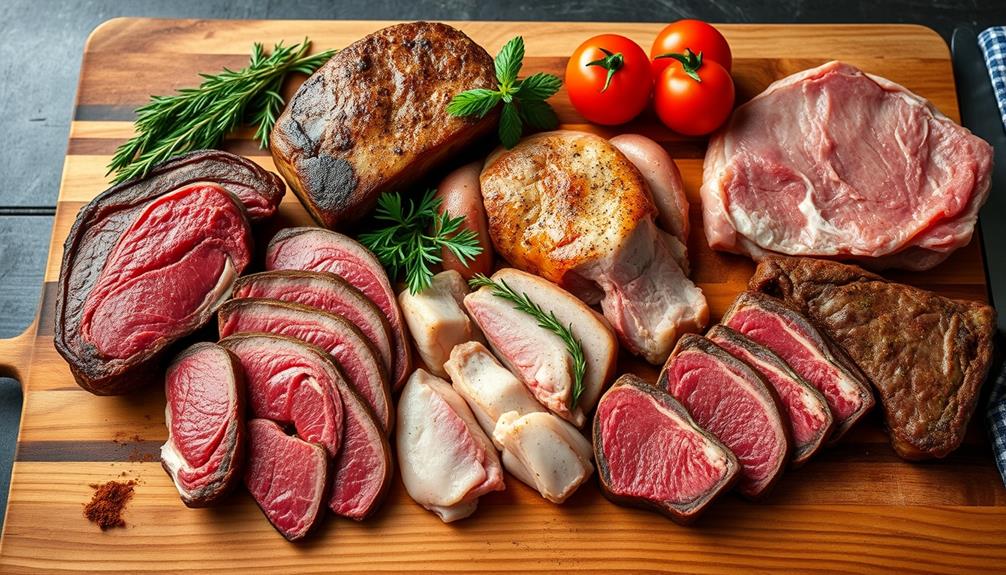
When selecting quality meat for your keto diet, you'll want to prioritize options that are plain and unprocessed. This guarantees you're getting the best meats for keto while maximizing your nutrient intake. Incorporating healthy fats from quality sources can also support overall wellness, much like essential oils for health.
Focus on these three key types:
- Grass-fed beef: Rich in omega-3 fatty acids and essential nutrients, it's a fantastic source of high-quality fats.
- Pasture-raised pork: This option not only tastes better but also contains higher levels of beneficial nutrients compared to conventional pork.
- Wild-caught fish: Packed with omega-3s, wild-caught fish provides healthy fats that fit perfectly into your high-fat diet.
When choosing quality meat, opt for fatty cuts of meat like ribeye or pork belly. These cuts help maintain satiety and support your high-fat macronutrient ratio.
Be cautious with processed meats; they often contain hidden sugars or starches that can throw off your carb intake.
Finally, select meats from regeneratively-raised animals to benefit from better nutrition and ethical farming practices.
Popular Keto Meats
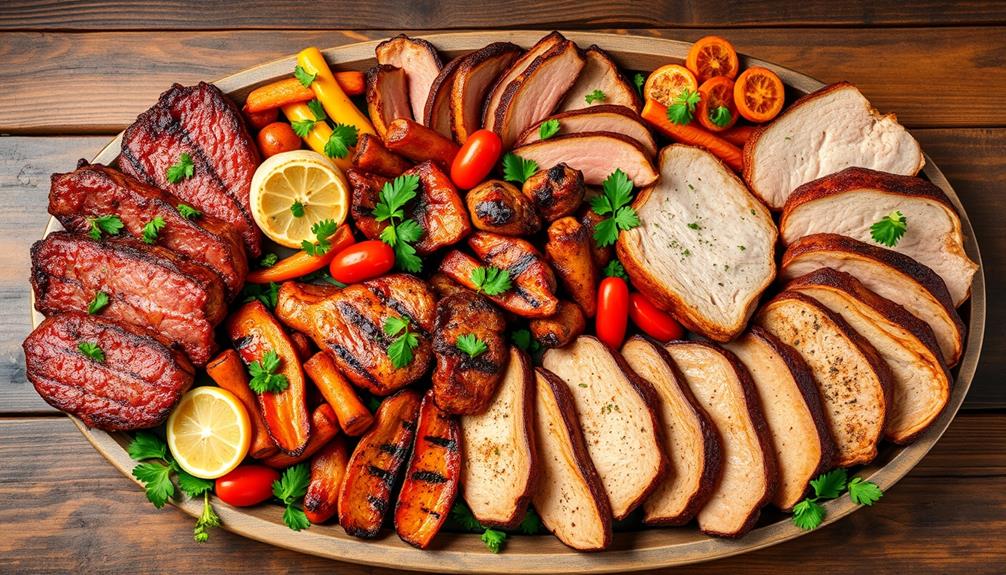
When it comes to popular keto meats, you're looking at options like grass-fed beef, pasture-raised pork, and fatty fish like salmon.
These meats aren't only rich in proteins and healthy fats but also align with a balanced diet rich in fruits, vegetables, and whole grains that supports overall health.
Each of these choices not only provides essential nutrients but also supports your keto goals with their unique protein and fat profiles.
Let's explore the nutritional benefits, recommended types, and some cooking tips to make the most of these delicious meats.
Nutritional Benefits of Meats
Choosing the right meats can greatly enhance your keto diet, providing crucial nutrients while keeping your carb intake low.
Additionally, incorporating healthy fats, such as those found in butter's health considerations, can complement your meals and support your ketogenic lifestyle.
When you focus on high-quality options, you'll enjoy impressive nutritional benefits that support your ketogenic lifestyle.
Here are three popular meats that fit perfectly into your keto plan:
- Grass-fed Beef: With about 20g of protein and essential nutrients like vitamin B12, iron, and omega-3 fats per 100g, this choice is nutrient-dense and ideal for keto dieters.
- Pasture-raised Pork: Offering 17g of protein and 21g of fat per 100g, it's rich in B vitamins, contributing to a balanced macronutrient profile perfect for your ketogenic needs.
- Fatty Fish (e.g., Salmon): Packed with 21g of protein and 7g of fat per 100g, it's high in omega-3 fatty acids, promoting heart health and reducing inflammation.
Incorporating these meats into your diet not only keeps your protein and fat intake in check but also guarantees you're getting crucial nutrients that support your overall health.
Enjoy these delicious options as you thrive on your keto journey!
Recommended Meat Types
For anyone serious about the keto diet, selecting the right types of meat is crucial for achieving success. Incorporating high-quality meats not only helps you meet your protein needs but also guarantees you're getting beneficial nutrients. Here are some popular keto-friendly options to take into account:
| Meat Type | Protein (per 100g) | Fat (per 100g) |
|---|---|---|
| Grass-Fed Beef | 20g | Varies |
| Pasture-Raised Pork | 17g | 21g |
| Chicken Thighs | 31g | Higher than breast |
| Fatty Fish (e.g., Salmon) | 21g | Varies (Omega-3 rich) |
| Bison | 20g | 7g |
Grass-fed beef is a fantastic source of protein and omega-3 fatty acids, while pasture-raised pork offers a flavorful option with a good fat content. Chicken thighs provide lean protein and higher fat, ideal for keeping you full. Fatty fish, like salmon, not only deliver protein but also support heart health due to their omega-3 richness. Finally, bison presents a lean protein source, making it an excellent choice for your keto meals.
Cooking Methods and Tips
Cooking keto-friendly meats can be a rewarding experience that enhances both flavor and nutrition. To get the best results, consider these cooking methods and tips for preparing your meats:
1. Marinate with Care: Use keto-friendly oils along with herbs and spices like garlic, rosemary, and paprika. This not only boosts flavor but also helps tenderize the meat.
Additionally, certain coffee varieties can complement savory dishes, adding a unique twist to your meals. Avoid sugary sauces that can ruin your low-carb goals.
2. Choose High-Fat Cuts: Opt for high-fat cuts like ribeye or pork belly. These cuts are perfect for the ketogenic diet, keeping you satisfied while ensuring you enjoy the benefits of healthy fats.
3. Try Different Cooking Techniques: Experiment with air frying or using a pressure cooker. Both methods are excellent for producing juicy results without needing excess fats or oils.
Cooking Tips for Keto Meats

When it comes to preparing meats for a keto diet, selecting high-fat cuts is essential for maximizing both flavor and satisfaction. Cuts like ribeye, pork belly, and chicken thighs not only taste amazing but also help keep you in ketosis.
To enhance your meal experience, consider pairing your meats with a rich coffee blend that can complement the savory flavors, as different brewing methods can influence the overall taste and caffeine levels in your dish various brewing methods.
To guarantee your meats are juicy and tender, utilize cooking methods such as grilling, roasting, or slow cooking, which help retain moisture and prevent that dry texture often found in lean cuts.
When it's time to season your meats, stick to keto-friendly spices and herbs. Avoid sugary marinades or sauces, as they can spike your carb counts. Instead, consider adding a touch of richness by using healthy fats like grass-fed butter, olive oil, or coconut oil while cooking, which boosts your overall fat intake.
Pair your delicious meats with low-carb vegetables like zucchini or cauliflower. They not only complement your protein but also provide essential nutrients without increasing your carbohydrate intake.
Meat Alternatives for Keto

Finding satisfying meat alternatives for a keto diet can expand your culinary options while keeping your carb intake low. Here are some great options to evaluate:
1. Eggs: With less than 1g of carbs and around 6g of high-protein per egg, they're versatile for a variety of keto recipes. Whether scrambled, poached, or in an omelet, eggs are a staple choice.
Additionally, incorporating fresh vegetables as safe snacks can enhance the nutritional profile of your meals, making them even more satisfying and healthy safe snacks for hamsters.
2. Canned Tuna and Sardines: These fish alternatives aren't only low-carb but also packed with omega-3 fatty acids, which are great for heart health. They can be easily added to salads or mixed with avocado for a delicious meal.
3. Nutritional Yeast: If you're looking for a plant-based option, this can mimic the savory flavor of cheese while providing essential B vitamins. It's low in carbs and can enhance the taste of many dishes.
While alternatives like tofu and tempeh exist, they may not provide a complete amino acid profile as animal proteins do.
If you have gluten sensitivities, avoid seitan, a popular wheat gluten option. Enjoy these meat alternatives to maintain a well-rounded keto diet!
Sustainable Meat Choices

Incorporating sustainable meat choices into your keto diet not only enhances your meals but also supports a healthier planet. By opting for grass-fed beef and pasture-raised pork, you're getting higher-quality fats and nutrients while promoting ethical practices in farming. These choices prioritize animal welfare and environmental health.
Consider adding wild-caught seafood like salmon and mackerel to your plate. These options provide lower levels of contaminants and encourage sustainable fishing practices that protect ocean ecosystems. Additionally, meats sourced from local farms practicing regenerative agriculture can enhance biodiversity and improve soil health, making them excellent sustainable options.
Here's a quick comparison of various sustainable meat choices:
| Meat Type | Benefits |
|---|---|
| Grass-Fed Beef | Higher-quality fats, supports animal welfare |
| Pasture-Raised Pork | Ethical farming, nutrient-rich |
| Wild-Caught Seafood | Lower contaminants, sustainable fishing |
Incorporating a variety of sustainable meats, including organic poultry and grass-fed lamb, not only contributes to a balanced keto diet but also supports agricultural practices that are better for the environment.
Meal Ideas With Keto Meats
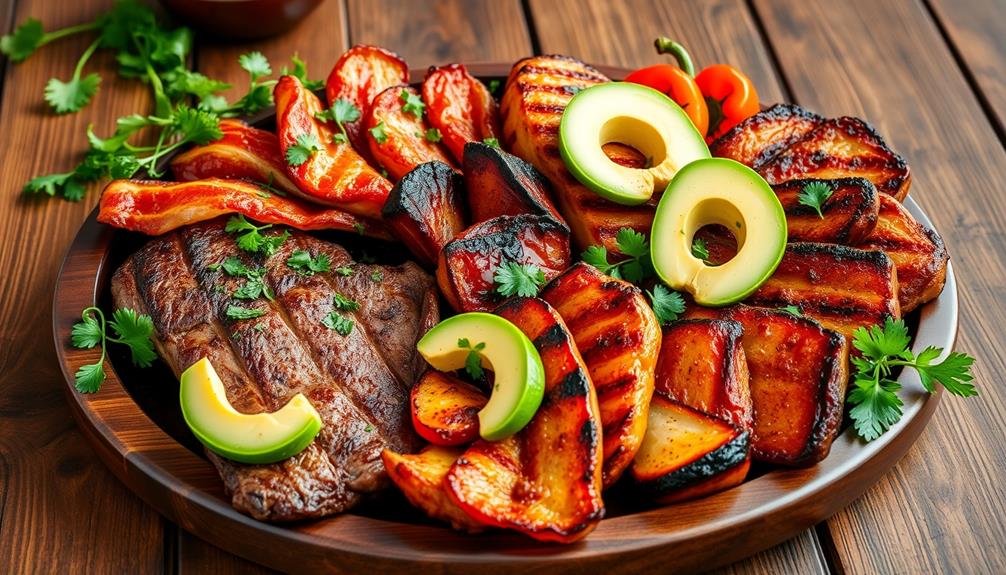
Delicious meal ideas await you with keto-friendly meats that not only satisfy your taste buds but also align with your dietary goals. Incorporating these high-protein, low-carb options will keep you energized and satisfied throughout the day.
Here are three tasty suggestions:
- Ribeye Steak: Sear a juicy grass-fed beef ribeye steak for a dinner packed with 20g of protein and healthy fats. Pair it with a side of sautéed spinach for a complete meal.
- Baked Salmon: Prepare baked salmon fillets seasoned with your favorite herbs. Each serving offers 21g of protein and a heart-healthy dose of omega-3 fatty acids, making it a perfect keto meal.
- Chicken Thighs: Opt for chicken thighs in a stir-fry or baked dish, delivering 31g of protein and 18g of fat. This guarantees a filling, low-carb meal that keeps you satisfied.
Don't forget about other options like rich pork belly or flavorful ground bison for variety.
With these meal ideas, you can enjoy the benefits of the keto diet while indulging in delicious, hearty dishes!
Frequently Asked Questions
What Is the Best Meat to Eat on Keto?
When you're choosing meat on keto, consider options like grass-fed beef, pasture-raised pork, or dark meat chicken. Fatty fish like salmon and organ meats also provide essential nutrients while keeping carbs low. Enjoy these for ideal health! When looking for the best ketofriendly meat options, also consider incorporating sources of healthy fats such as bacon, sausage, and fatty cuts of lamb. These meats can provide a satisfying and delicious way to meet your macro goals while ensuring your body receives the necessary nutrients for success on the keto diet.
What Meat Is Not Keto-Friendly?
When it comes to staying on track, you've gotta watch out for battered meats, sweet sauces, and processed options. These can sneak in hidden sugars and carbs, derailing your keto goals faster than you think!
What Meats Are Lowest in Carbs?
When you're looking for meats lowest in carbs, focus on options like beef, pork, chicken, and fatty cuts like ribeye. Seafood, especially salmon, is great too, providing healthy fats without any carbs.
Can I Eat Meat Every Day on a Keto Diet?
Yes, you can eat meat every day on a keto diet. It's low in carbs and high in protein, helping you maintain ketosis. Just choose unprocessed options and vary your meats for balanced nutrition.
Conclusion
Incorporating the right meats into your keto diet can be as satisfying as a well-crafted puzzle, where every piece fits perfectly to support your health goals. By choosing quality cuts, exploring diverse options, and using clever cooking techniques, you'll not only enjoy delicious meals but also reap the nutritional benefits they offer. Remember, balance is key, so don't hesitate to experiment with different flavors and textures to keep your keto journey exciting and fulfilling!
